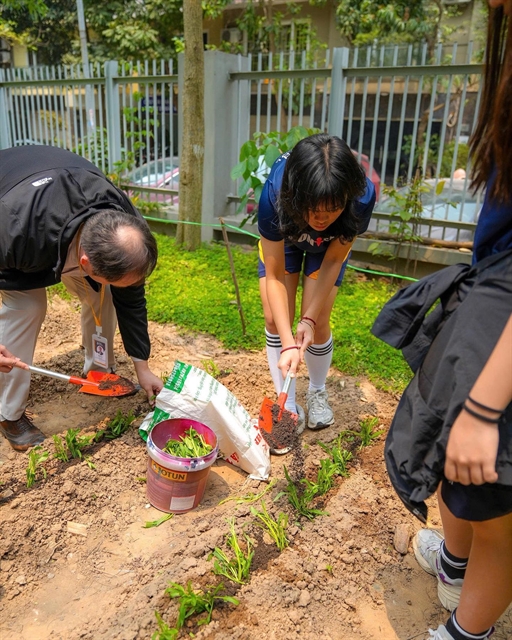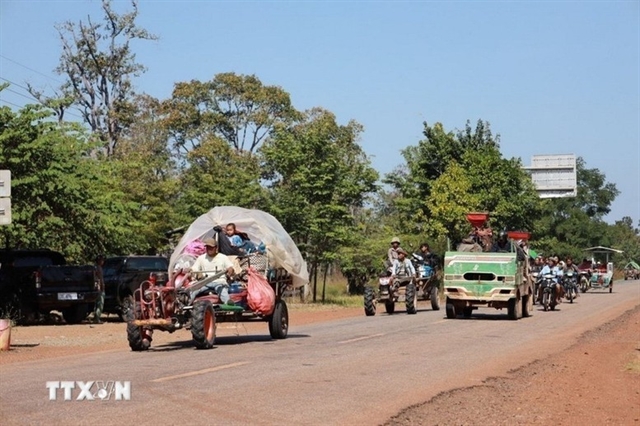 Environment
Environment


|
| A severe landslide along a bank of the Tiền River in Thanh Bình District in the Mekong Delta province of Đồng Tháp. — VNA/VNS Photo Nguyễn Văn Trí |
HCM CITY — The Cửu Long (Mekong) Delta region needs “consistent strategies” to deal with groundwater extraction, land subsidence and saltwater intrusion in an increasingly urbanising area, experts said yesterday at a conference in HCM City.
Speaking at the online event, Nguyễn Hữu Thiện, an expert on Mekong Delta ecology, said that land subsidence is a threat to many of the world’s deltas, especially the Mekong Delta in Việt Nam.
The overexploitation of groundwater in the region has contributed to severe land subsidence and will lead to devastating consequences if the practice continues, according to the expert.
“It is essential to support policymakers in exploring suitable, consistent strategies for mitigating subsidence in a participatory manner.”
In recent years, data has become available showing the rate at which the Mekong Delta is subsiding, according to the Ministry of Natural Resources and Environment.
Thiện, who is deputy head of the Governance of Land Subsidence and Groundwater Management for the Mekong Delta project, said it was paramount to identify alternative water sources, the value of water sources, and the link between groundwater extraction and land subsidence.
Begun in January 2020 and completed last month, the project aimed to enhance the capabilities of individuals and organisations to develop sustainable strategies for dealing with the problems.
Under the project, a new integrated delta model linked surface water, groundwater and geo-mechanical models in order to analyse the interrelated character of groundwater extraction, subsidence levels and saltwater intrusion.
The integrated model was applied to quantify the effects of water management strategies in the Mekong Delta.
Strategies were developed by simulating and demonstrating the effects of development scenarios and policy recommendations as mentioned in the Mekong Delta Plan in 2013.
Four case-study fact sheets of Cần Thơ City and Bến Tre, Sóc Trăng, and Kiên Giang provinces have been developed. The four provinces all face major problems concerning land subsidence and groundwater extraction depending on location-specific characteristics.
The key challenges, needs and opportunities for governance of land subsidence and groundwater management were identified with the support of several workshops, close collaboration with Cần Thơ University, and key actors in the Mekong Delta.
The Ministry of Natural Resources and Environment has issued a decree that requires zoning plans to cope with land subsidence. Each province is at a different stage of implementing the decree.
The four pilot provinces indicated common challenges: a scarcity of available data to be used in decision-making, a lack of a proper monitoring network, insufficient financial incentives (pricing), a lack of spatial planning, little regional coordination, limited regulations for groundwater extraction, and scarce financial and technical capacities.
The project has contributed to good water governance, closing the disconnect between local communities and decision-makers. At a later stage, a collaborative learning process can start, creating flexibility in the set goals.
Project challenges
While further research is necessary to identify hotspots in the Mekong Delta, experts said it was clear from the evidence that land subsidence induced by groundwater extractions could lead to increased flood vulnerability and damage to infrastructure and buildings.
Groundwater extractions are augmented by changes in weather extremes and climate change leading to increased saltwater intrusion and droughts, intensifying issues in the Mekong Delta, according to the experts.
Groundwater extraction and resulting land subsidence is a gradual process, but vital tipping points should be avoided. These could have financial implications as well as affect a wide variety of livelihoods.
Việt Nam and the Netherlands signed the Strategic Partnership Arrangement on Climate Adaptation and Water Management under the Mekong Delta Plan in 2013.
Since then, the two countries and international stakeholders have collaborated to translate the plan’s vision into concrete policy ambitions.
The Mekong Delta, the country’s largest rice, fruit and seafood producer, is facing a land subsidence rate of 1 cm per year, with some areas reaching a rate of 5.7 cm, according to the Ministry of Natural Resources and Environment.
Cần Thơ City has the highest rate of land subsidence, with more than 5 cm in most areas during the 2015 - 19 period.
The rapidly increasing population and economic development are driving a rapid increase in water consumption. The associated extraction of groundwater for drinking water, agriculture and fisheries is to blame for the dramatic land subsidence in the low-lying region. — VNS




